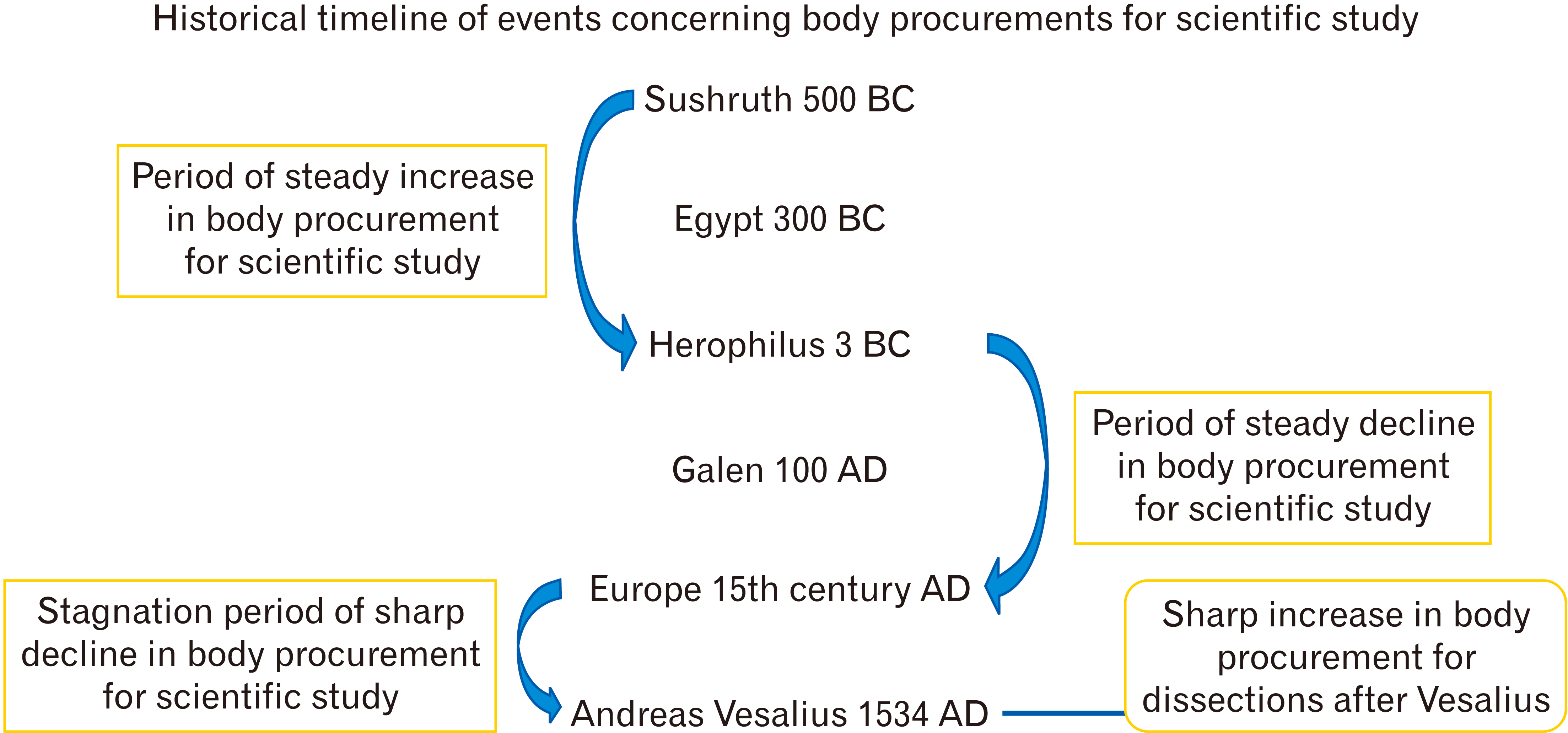Introduction
Review
Pre-historic body/organ donations and its applications
Later historic acts concerning body donation
Enactment of laws worldwide
The Indian scenario after independence
Table 1
| No | State anatomy acts of concerned state | Maximum degree of tolerable collateral consanguinity of a near relative for claiming the dead body [10, 15] |
Maximum time period within which a body has to be procured [10, 15] |
Accountabilty of the type of person who can claim a deceased body [15, 17] | Accountabilty for voluntary donation of cadavers [15, 17] | Accountability for therapeutic use of cadavers apart from anatomical research [14, 17] | Funeral embalming provisions [14, 17] |
|---|---|---|---|---|---|---|---|
| 1 | Maharashtra | Upto 6th | Upto 48 hours | Only near relatives | Included | Included | Under discussion |
| 2 | Delhi | Upto 6th | Upto 48 hours | Near relatives as well as friends | Not included | Not included | Under discussion |
| 3 | Kerala | Upto 6th | Not included or mentioned | Near relatives or friends or religious bodies affiliated to the deceased person | Included | Not included | Under discussion |
| 4 | Orissa | Upto 6th | Upto 48 hours | Only near relatives | Included | Not included | No provisions |
| 5 | Tamilnadu | Upto 6th | Not included or mentioned | Only near relatives | Not included | Not included | Under discussion |
| 6 | UP | Upto 12th | Upto 48 hours | Only near relatives | Included | Not incuded | No provisions |
| 7 | Haryana | Upto 6th | Not included or mentioned | Only near relatives | Not included | Included | No provisions |
| 8 | Goa | Upto 6th | Not included or mentioned | Only near relatives | Not included | Included | No provisions |
| 9 |
Himachal Pradesh |
Upto 6th | Least time delay not specified correctly | Only near relatives | Not included | Included | No provisions |
| 10 | Karnataka | Upto 6th | Upto 48 hours | Only near relatives | Included | Not included | No provisions |
| 11 | Andhra Pradesh & Telangana | Upto 6th | Upto 48 hours | Only near relatives | Included | Included | Under discussion |
Limitations
Body Donations Governed by Vivid Laws Across the Globe
Table 2
| No. | Aspect of body procurement/donation |
North America [22, 25] |
Europe [23, 29] |
India [10, 17] |
Thailand [24, 25] |
South Korea [26-26, 29] |
Australia [22-26] |
Middle east & certain African nations [23-26] |
|---|---|---|---|---|---|---|---|---|
| 1 | Acts/laws governing it | Vested with federal states or provinces | Centralized for the country | Vested with states | Centralized | Centralized | Vested with federal states or provinces | Vested with the religious laws |
| 2 | Autonomy | Self willed | Restricted self willed by lawyer intervention | No provisions so far | No provisions so far | Restricted self willed by lawyer intervention | Self willed | Based on the regional religion |
| 3 | Therapeutic use of cadavers | Accounted and considered | Accounte d and considered | Considered but not accounted by all states | Not considered | Considered but not fully accounted | Accounted and considered | Based on religious jurisdiction and norms |
| 4 | Funeral embalming | Provisions made | Provisions made | No provisions | No provisions | Provisions made | Provision made | Provisions made |
| 5 | Transportation cost of cadaver | Provisions made | Provisions made | No provisions | No provisions | Provisions made | Provision made | Provisions made |
Future prospects and our recommendations
In this era of One India-One Nation, where the unification of diversity instead of unity in diversity is the prominent ideology, it is high time that we should settle on a Unified Anatomy Act for the entire nation. It can curb various issues arising from the many state acts and bring clarity and unification of rules and procedures.
Both national and state Anatomical associations must actively work to amend state acts so that a unified Anatomy Act can take their place.
Additionally, it would be very helpful to set up an online database where medical colleges could list their cadaver requirements and easily report unclaimed bodies. It can avoid wasting potentially valuable cadaveric resources. Also, appropriate protocols and procedures should be set up to move and preserve the cadavers from the collection site to the medical institutions which are in need of cadavers for teaching.
Online and offline awareness campaigns can be run to educate people about the value of voluntary body donation and to dispel the stigma attached to it. The common man should be encouraged to donate his body to medical education in order to expel the demons of ignorance and produce outstanding doctors and surgeons who will make our nation proud.




 PDF
PDF Citation
Citation Print
Print




 XML Download
XML Download